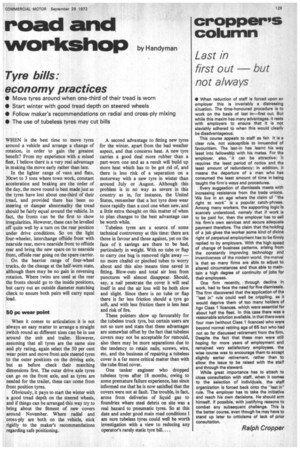cropper's column
Page 131

If you've noticed an error in this article please click here to report it so we can fix it.
Last in first out but not always
• When reduction of staff is forced upon an employer this is invariably a distressing s:tuation. The time-honoured procedure is to work on the basis of last in—first out. Silt while this maxim has many advantages, it rests with employers to ensure that it is not slavishly adhered to when this would clearly be disadvantageous.
This course appeals to staff as fair. It is a clear rule, not susceptible to innuendos of favouritism. The last-in has learnt his way least into fellowship with his mates. For the employer, also, it can be attractive: it requires the least period of notice and the least amount of redundancy; in addition, it means the departure of a man who has consumed the least amount of time in being taught the firm's ways and procedures.
Every suggestion of dismissals meets with increasing resistance from the trade unions. We live in an age where the claim of "the right to work" is a popular catch-phrase. Among many workers, the supporting logic is scarcely understood, namely that if work is to be paid for, then the employer has to sell his firm's own services and secure adequate payment therefore. The claim that the holding of a job gives the worker some kind of divine right of perpetual employment has to be firmly replied to by employers. With the high speed of change of business patterns, arising from the constantly improving technology and inventiveness of the modern world, the marvel is that so many firms are able to adjust to altered circumstances and thus able to maintain a high degree of continuity of jobs for their employees.
One firm recently, through decline in work, had to face the need for five dismissals. The firm discovered that the application of the "last in" rule could well be crippling, as it would deprive them of too many holders of hgv Class 1 licences, which were essential for about half the fleet. In this case there was a reasonable solution available, in that there were four men (without Class 1 licences) who were beyond normal retiring age of 65 but who had not so far discussed retirement from the firm. Despite the fact that these men were still hoping for more years of employment and remained very satisfactory employees, the wise course was to encourage them to accept slightly earlier retirement, rather than to allow the issue to be raised with the staff and through the steward.
While great importance has to attach to close consultation with staff, when it comes to the selection of individuals, the staff organization is forced back onto the "last in" rule. The employer has to take the initiative and reach his own decisions. He should arm himself, if possible, with justifying reasons to combat any subsequent challenge. This is the better course, even though he may have to stand up later to criticisms of lack of prior consultation.
Ralph Cropper








































































































































































































































